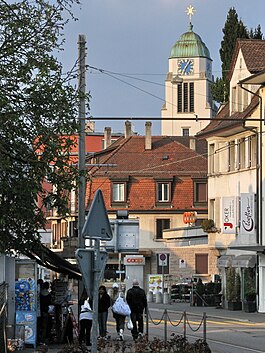Dietikon
| Dietikon | ||
|---|---|---|
 |
||
|
||
| Coordinates: 47°24′N 8°24′E / 47.400°N 8.400°ECoordinates: 47°24′N 8°24′E / 47.400°N 8.400°E | ||
| Country | Switzerland | |
| Canton | Zurich | |
| District | Dietikon | |
| Government | ||
| • Executive |
Stadtrat with 7 members |
|
| • Mayor |
Stadtpräsident Otto Müller (as of March 2014) |
|
| • Parliament |
Gemeinderat with 36 members |
|
| Area | ||
| • Total | 9.33 km2 (3.60 sq mi) | |
| Elevation | 388 m (1,273 ft) | |
| Population (Dec 2015) | ||
| • Total | 26,633 | |
| • Density | 2,900/km2 (7,400/sq mi) | |
| Postal code | 8953 | |
| SFOS number | 0243 | |
| Surrounded by | Bergdietikon (AG), Geroldswil, Oetwil an der Limmat, Schlieren, Spreitenbach (AG), Unterengstringen, Urdorf, Weiningen | |
| Twin towns | Kolín (Czech Republic), Braggio (Switzerland), Renens (Switzerland) | |
| Website |
www SFSO statistics |
|
Dietikon is the fifth biggest city of the canton of Zürich in Switzerland, after Zürich, Winterthur, Uster and Dübendorf. It is the capital of the same-named district of Dietikon and part of the Zürich metropolitan area.
The industrial city Dietikon is situated at an elevation of 388 m (1,273 ft) at the confluence of the Reppisch and the Limmat, located in the Limmat Valley (German: Limmattal), along the railway line from Zürich to Baden. Here and in the neighboring region, Spreitenbach, is also the large Limmattal rail freight marshalling yard.
Dietikon has an area of 9.3 square kilometers (3.6 sq mi). Of this area, 17.2% is used for agricultural purposes, while 27% is forested. Of the rest of the land, 49.1% is settled (buildings or roads) and the remainder (6.7%) is non-productive (rivers, glaciers or mountains). In 1996[update] housing and buildings made up 33.8% of the total area, while transportation infrastructure made up the rest (15.3%). Of the total unproductive area, water (streams and lakes) made up 4.9% of the area. As of 2007[update] 40.7% of the total municipal area was undergoing some type of construction.
The largest and best known forests of the municipality include the Honeret, Guggenbüehl and Röhrenmoos.
The Honeret forest lies on a side moraine of the Linth glacier ("Linthgletscher"). There are over 200 prominent stones through the woods, up to erratic boulders as big as 25 m2 (270 sq ft). The Honeret and the Guggenbüehl-Wald are separated by only one main street. In the forest, there are a few springs from which the brooks Tobelbach and Stoffelbach rise and then flow down into the Reppisch. Also in the forest lies the forest cottage "Lorenzhütte."
...
Wikipedia



